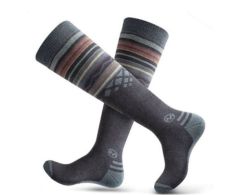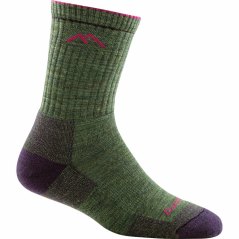BestReviews is reader-supported and may earn an affiliate commission. Details

Our fitness expert owns and recommends investing in these ruggedly made and comfortable men’s hiking socks for wet and cold climates.
Especially durable, comfortable, breathable, and stylish. Dries quickly. No toe seams. Will not bunch up inside hiking boots. Reliable elastic keeps socks in place. Available in a range of colors. Quality and longevity makes them worth the price.
Relatively pricey, but you get what you pay for.

Available in different sizes and sold as a 3-pack, these warm and durable socks present an impressive value.
Thick, comfortable socks made of 75 percent merino wool. These are tall socks that come up over calves and don’t fall down, even on athletic calves. Keep feet warm without causing them to overheat or sweat. Keep feet dry even if shoes get wet.
These may shrink a bit in the dryer.

Users praise these high-calf socks for staying in place, unlike many competitors in this style.
Two-pair set of flexible, forgiving socks made with 30 percent merino wool. Designed with slip-free cuffs, which prevent socks from slouching. Lightweight construction that prevents blisters and hot spots during cold-weather sports. Choice of sizes and colors.
Not the warmest socks on our shortlist, since there's a lower wool percentage.

Designed with hiking boots in mind, these socks get high marks for cushioning feet on long treks.
Supportive socks with plenty of under foot cushioning. Made from 59 percent merino wool. Fine-gauge knitting and seamless construction make these the most comfortable hikers many women have worn. Choice of sizes and colors.
Some customers found the sizing rather inconsistent.

These merino-blend socks provide excellent moisture wicking, despite their consistent, thick weave.
Thermal-lined socks made with 41 percent merino wool. Reinforced in the toe and heel for long, durable wear. Moisture-wicking design and flattened toe seam helps prevent blisters. Thick weave that provides uniform cushioning throughout the sock. Choice of sizes and colors.
Some socks became discolored over time, and tended to shrink.

We recommend these products based on an intensive research process that's designed to cut through the noise and find the top products in this space. Guided by experts, we spend hours looking into the factors that matter, to bring you these selections.

If you associate wool with itchy skin and irritation, it’s because you’ve never experienced merino wool. Shorn from merino sheep, this wool is ultra-soft and temperature regulating, which means it works well in cold and warm weather alike. Merino wool is an excellent sock material, keeping your feet warm without making them clammy.
Before you go ahead and add a pair of merino wool socks to your shopping cart, there are a few factors to consider. Are you wearing the socks with rain boots, snow boots, or low sneakers? This will determine the ideal sock height. You’ll also want to think about sock color, padding, sizing, and whether or not they can be washed in a washing machine.

Merino wool comes from merino sheep, which originated in Spain. Today, Australia is home to the largest merino sheep population and is the world’s leading exporter of wool. South Africa, South America, and the United States also raise merino sheep.
Merino sheep are typically shorn once a year, ideally during the summer. Once the sheep’s back, sides, belly, and upper legs are shorn, the wool is placed on a table with several closely spaced slates. Debris and short pieces of wool fall through the slats. Next, the wool is skirted to remove the last of any impurities. Following the skirting process, the wool undergoes one last quality check before being packed into a bale and shipped off to manufacturers to be made into various garments.
Merino sheep live in temperatures ranging from 5°F to 95°F. They’re able to exist in such a range of temperatures because of the wool’s temperature-regulating properties. When the air is cold, the natural bends in the wool’s fiber trap air and keep the animal warm. When the air is hot, the wool wicks sweat and moisture away from the skin, keeping the animal cooler. This moisture-wicking property means merino wool is better for athletes than synthetic fibers, particularly those who enjoy outdoor sports in the summer. And in colder temperatures, merino wool easily lends itself to layering.
As you likely know, wool is prone to shrinking, especially in the dryer, but that doesn’t apply to all merino wool socks. Preshrunk merino wool socks are safe to toss in the dryer. If the socks aren’t marked as preshrunk, your best bet is to hand-wash them in cold water and mild soap, or wash them on the gentle cycle with cold water in the washer. Dry on low or hang them up to air-dry.
Like with any socks, merino wool socks are available in varying heights and sizes. Since merino wool socks are popular in winter and often worn with boots, it's easy to find them at ankle length or higher. Crew socks will bring some extra warmth, while knee socks are popular with snowboarders, skiers, and other winter athletes.
To better protect winter athletes from the elements, knee socks are frequently padded, particularly around the shins. There can also be padding around the foot and lower leg of the sock. If you're going hiking, look for boots with padding in the heels, toes and shins.
Merino wool comes in varying degrees of fineness, depending on the type of merino sheep that it’s sourced from.
Peppin: Most of the wool is from Peppin merino sheep, which make up 70% of Australia’s merino sheep population. A strand of wool from Peppin sheep measures from 20 to 23 microns in diameter. Compare that to the average human hair, which is 75 microns in diameter.
Saxon: Ultrafine wool comes from Saxon merino sheep. It is typically 16 microns or less in diameter. With its high price tag, ultrafine merino wool is found more often in luxury items than in socks for everyday wear.
Height: You can find low-cut merino wool crew socks to wear with low shoes, as well as crew, mid-calf, knee-high, and even over-the-knee socks. The taller the socks, the higher the price.
Color: You’ll have no trouble finding merino wool socks in neutral colors (think black, brown, and gray) and some brighter colors like red. These are not the socks for a bold fashion statement, but at least they’ll keep your feet toasty. There are also plenty of merino wool socks in bright patterns and colors.
Merino wool socks aren’t your average socks, so expect to pay a little more per pair. With their temperature-regulating properties, merino wool socks are well worth it. A typical pair will run you roughly $10 to $25, or more, depending on quantity and wool fineness.
Inexpensive: It’s possible to find merino wool socks for under $10. These socks include a blend of other fibers, such as cotton, acrylic, or nylon. The percentage of merino wool in these socks is probably under 50%. This is fine for some circumstances, but it will diminish the insulation properties of the socks.
Mid-range: A more common price range for these socks is $10 to $20. The price depends on the fineness of the wool, and most of the socks in this range have 50% to 70% merino wool, along with other fibers. Some socks list the merino wool as “ultrafine.” Keep in mind that even coarser merino wool is “fine” compared to other types of wool.
Expensive: Merino wool socks that cost over $20 contain the highest percentage of merino wool, as much as 80%. You’ll also find packs of two, three, or more pairs of lesser-quality socks in this range.

Q. Does merino wool pill?
A. Tightly woven merino wool is less likely to pill than cotton or synthetic fibers. When it does happen, it’s usually from friction in the washer or dryer. You can remedy this by turning the socks inside out to wash them.
Q. Are merino wool socks better than regular wool socks?
A. Wool, in general, refers to the hair shorn from furry animals such as rabbits, sheep, and goats. What sets merino wool apart is its fineness, durability, and adaptability.
Q. Do merino wool socks include 100% merino wool?
A. You’d be hard-pressed to find 100% wool socks, merino or not. Today’s socks nearly always include spandex for extra stretch. Other fibers are added for other qualities while lowering the manufacturer’s production costs.
Get emails you’ll love.
Learn about the products you’re wondering if you should buy and get advice on using your latest purchases.
